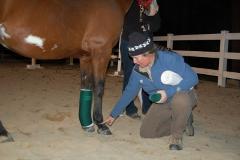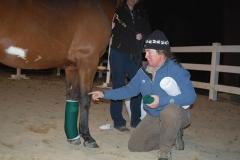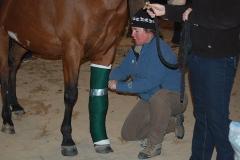“In the event of an emergency…” or a flood, tornado, earthquake, or an injury while you’re out riding – what would you do for your horse(s)? On October 20, Caryn and Ben Holden hosted an Emergency Preparedness Seminar, presented by Jennifer Dunlap, DVM, at their farm in Oakland, TN. Dr. Dunlap spent a couple of hours explaining in great detail how to help horses survive is a variety of emergency situations.
Out of the pain and suffering of animals not rescued from Hurricane Katrina came the Pets Evacuation and Transportation Standards Act (PETS Act), which requires states seeking Federal Emergency Management Agency (FEMA) assistance to accommodate pets and service animals in their plan for evacuating residents following disasters. Horse owners have a more difficult task than dog, cat and pocket pet owners. Because of a horse’s size and transportation needs, more planning must go into an equine evacuation plan. Following are some General Disaster Preparedness Guidelines.
Your first priority to make sure YOU are prepared for an emergency situation. Stay hydrated by drinking adequate volumes of water. Wear appropriate clothing. Remain as calm as possible Gentle but assertive guidance works best with horses. Keep your barn clean and free of debris so horses can be evacuated quickly and safely. Have halters and lead ropes readily available by each horse’s stall. Stockpile water and food for yourself and your animals. Have a week’s worth of feed and hay packaged in waterproof containers for your horses. Keep your equipment in good repair. Develop a written disaster plan, with evacuation routes planned. If evacuation is not possible, decide which is safest for your horse – turned out or in the barn.
Horse Identification
After Hurricane Andrew, 80% of horses had no identification system, so reuniting them with their owners proved extremely difficult.Take a photo of your horse with family members in the photo, too. Include close up photos of identifying marks. Attach your Coggin’s test papers to the photos and, if microchipped, place chip certificate with Coggin’s papers and photos. Place a leather halter on your horse. Attach a luggage tag to your horse’s halter with your name, phone number, address, and any medication information. Braid a second luggage tag into your horse’s tail with the same information on it.
Barn Fires
Preventing barn fires and being prepared in the event of a fire can mean life or death for your horses. Prevention is key!
Prohibit smoking in or around the barn. Avoid parking tractors and vehicles in or near the barn. Inspect electrical systems regularly and immediately correct any problems. Rodents can chew on electrical wiring and cause damage that quickly becomes a fire hazard. Keep appliances in the barn to a minimum. Use stall fans, space heaters, and radios only when someone is in the barn. Be sure hay is thoroughly dry before storing it. Hay that is too moist may combust (the wet grass in the tightly packed bale generates heat). Store hay outside the barn in a dry, covered area when possible.
Be prepared in case of a barn fire. Keep aisles, stall doors, and barn doors free of debris and equipment. Mount fire extinguishers around the stable, especially at all entrances. Have a planned evacuation route for every stall in the barn. Have emergency phone numbers posted at each telephone and entrance. Keep your barn’s street address clearly posted to relay to the 911 operator. Consider installing smoke alarms and heat detectors throughout your barn. Familiarize your horses with emergency procedures and common activities they would encounter in a disaster; e.g., desensitize them to flashlights and flashing lights.
[Note: Shelby Farms Equestrian Alliance offers annually a seminar for emergency personnel to teach them how to handle horses in various types of accident and emergency situations.]
In the event of a Barn Fire
Call 911 or your local fire department! Do not enter the barn if it is already engulfed in flames. If safe to enter the barn, evacuate horses one at a time starting with the most accessible horses, using a halter and lead rope on each horse. Move horses to paddocks close enough to reach quickly, but far enough from the barn so horses won’t be affected by fire and smoke. Never let horses loose in an area where they can return to the barn.
Flooding
If your barn is in a flood plain, plan to evacuate your horses in the event of a flood. Horses cannot forage under water and if water gets too high, they can drown. The county emergency agency will be able to tell you where emergency evacuation barns have been set up. Be aware that flood waters can contain human waste and other harmful bacteria. If your horses contact flood waters, decontaminate them with Dawn dishwashing soap while wearing gloves and protective clothing.
Taking TPR and Gut Sounds
Normal temperature (T) obtained rectally is 90- 100.9.
Normal pulse rate (P): 28-44 beats per minute.
Normal respiratory rate (R): 8-16 breaths per minute.
Normal gut sounds: should hear gurgling in all four quadrants. Gut sounds are louder when a horse is eating and softer after hard exercise.
Know what is normal for your horse.
Bandaging
Horse’s soft tissue coverage over the lower limbs can be damaged is the bandage is too tight.
Leg bandages have 2 to 3 parts:
1. If a wound, first an absorbent layer, generally 4X4 gauze +/- ointment.
2. A soft supportive layer: a Combine roll, cast padding, or No-Bow wraps.
3. A securing layer: Vetrap, track bandage, or standing bandage.
Hoof bandages have multiple layers. Basic emergency hoof warp: diaper and duct tape. Put bandage over a wide area to keep it from binding. Generally:
a. Hooves: go up to pastern area
b. Pastern: go from mid-fetlock down over hoof
c. Flexor tendons: from below fetlock to just below knee
d. Knee: use a stack bandage.
Keep the roll of your bandage to the outside and roll with gentle, even pressure. Practice! Practice bandaging to get it right so that the bandage will not further damage the horse.
Out of the pain and suffering of animals not rescued from Hurricane Katrina came the Pets Evacuation and Transportation Standards Act (PETS Act), which requires states seeking Federal Emergency Management Agency (FEMA) assistance to accommodate pets and service animals in their plan for evacuating residents following disasters. Horse owners have a more difficult task than dog, cat and pocket pet owners. Because of a horse’s size and transportation needs, more planning must go into an equine evacuation plan. Following are some General Disaster Preparedness Guidelines.
Your first priority to make sure YOU are prepared for an emergency situation. Stay hydrated by drinking adequate volumes of water. Wear appropriate clothing. Remain as calm as possible Gentle but assertive guidance works best with horses. Keep your barn clean and free of debris so horses can be evacuated quickly and safely. Have halters and lead ropes readily available by each horse’s stall. Stockpile water and food for yourself and your animals. Have a week’s worth of feed and hay packaged in waterproof containers for your horses. Keep your equipment in good repair. Develop a written disaster plan, with evacuation routes planned. If evacuation is not possible, decide which is safest for your horse – turned out or in the barn.
Horse Identification
After Hurricane Andrew, 80% of horses had no identification system, so reuniting them with their owners proved extremely difficult.Take a photo of your horse with family members in the photo, too. Include close up photos of identifying marks. Attach your Coggin’s test papers to the photos and, if microchipped, place chip certificate with Coggin’s papers and photos. Place a leather halter on your horse. Attach a luggage tag to your horse’s halter with your name, phone number, address, and any medication information. Braid a second luggage tag into your horse’s tail with the same information on it.
Barn Fires
Preventing barn fires and being prepared in the event of a fire can mean life or death for your horses. Prevention is key!
Prohibit smoking in or around the barn. Avoid parking tractors and vehicles in or near the barn. Inspect electrical systems regularly and immediately correct any problems. Rodents can chew on electrical wiring and cause damage that quickly becomes a fire hazard. Keep appliances in the barn to a minimum. Use stall fans, space heaters, and radios only when someone is in the barn. Be sure hay is thoroughly dry before storing it. Hay that is too moist may combust (the wet grass in the tightly packed bale generates heat). Store hay outside the barn in a dry, covered area when possible.
Be prepared in case of a barn fire. Keep aisles, stall doors, and barn doors free of debris and equipment. Mount fire extinguishers around the stable, especially at all entrances. Have a planned evacuation route for every stall in the barn. Have emergency phone numbers posted at each telephone and entrance. Keep your barn’s street address clearly posted to relay to the 911 operator. Consider installing smoke alarms and heat detectors throughout your barn. Familiarize your horses with emergency procedures and common activities they would encounter in a disaster; e.g., desensitize them to flashlights and flashing lights.
[Note: Shelby Farms Equestrian Alliance offers annually a seminar for emergency personnel to teach them how to handle horses in various types of accident and emergency situations.]
In the event of a Barn Fire
Call 911 or your local fire department! Do not enter the barn if it is already engulfed in flames. If safe to enter the barn, evacuate horses one at a time starting with the most accessible horses, using a halter and lead rope on each horse. Move horses to paddocks close enough to reach quickly, but far enough from the barn so horses won’t be affected by fire and smoke. Never let horses loose in an area where they can return to the barn.
Flooding
If your barn is in a flood plain, plan to evacuate your horses in the event of a flood. Horses cannot forage under water and if water gets too high, they can drown. The county emergency agency will be able to tell you where emergency evacuation barns have been set up. Be aware that flood waters can contain human waste and other harmful bacteria. If your horses contact flood waters, decontaminate them with Dawn dishwashing soap while wearing gloves and protective clothing.
Taking TPR and Gut Sounds
Normal temperature (T) obtained rectally is 90- 100.9.
Normal pulse rate (P): 28-44 beats per minute.
Normal respiratory rate (R): 8-16 breaths per minute.
Normal gut sounds: should hear gurgling in all four quadrants. Gut sounds are louder when a horse is eating and softer after hard exercise.
Know what is normal for your horse.
Bandaging
Horse’s soft tissue coverage over the lower limbs can be damaged is the bandage is too tight.
Leg bandages have 2 to 3 parts:
1. If a wound, first an absorbent layer, generally 4X4 gauze +/- ointment.
2. A soft supportive layer: a Combine roll, cast padding, or No-Bow wraps.
3. A securing layer: Vetrap, track bandage, or standing bandage.
Hoof bandages have multiple layers. Basic emergency hoof warp: diaper and duct tape. Put bandage over a wide area to keep it from binding. Generally:
a. Hooves: go up to pastern area
b. Pastern: go from mid-fetlock down over hoof
c. Flexor tendons: from below fetlock to just below knee
d. Knee: use a stack bandage.
Keep the roll of your bandage to the outside and roll with gentle, even pressure. Practice! Practice bandaging to get it right so that the bandage will not further damage the horse.













